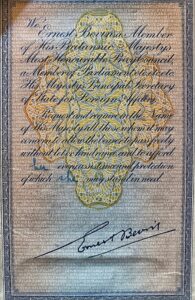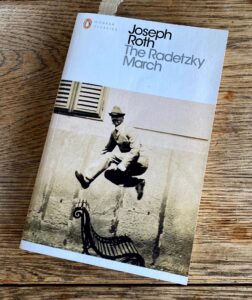When Britain was a world power
Inside page of a British passport in the late 1940s.
It reads:
We, Ernest Bevin, a Member of His Britannic Majesty’s Most Honourable Privy Council, a Member of Parliament, etc.etc. His Majesty’s Principal Secretary of State for Foreign Affairs, Request and require in the name of His Majesty all those whom it may concern to allow the bearer to pass freely without let or hindrance, and to afford her every assistance and protection of which she may stand in need.
Those were the days. I wonder what the Brexit version says.
Quote of the Day
“An acre in Middlesex is better than a Principality in Utopia”.
- Thomas Macaulay
(Especially now, given London property prices.)
Musical alternative to the morning’s radio news
Grieg – Piano Concerto II. Adagio | Arthur Rubinstein (7 minutes)
Rubinstein in the finest white tie I’ve ever seen. Olympic-class sharp dressing. Conducted by a youthful Andre Previn.
US Air Force shows off latest all-electric flying car, says it ‘might seem straight out of a Hollywood movie’
Er, not if it’s an action movie.
From The Register
The US Air Force has revealed a prototype of a flying car, something the American military has desired for at least a decade.
The latest build is single-person aircraft – specifically, a version of the Lift Hexa copter, which uses 18 electric motors that allow it to take off and land vertically. The vehicle was put through its paces last Friday at the Texas State Guard’s Camp Mabry base.
The craft is part of a project the Air Force is running called Agility Prime, which has tapped up Lift and other manufacturers to develop single-person “flying car” aircraft for field tests within the next three years. Other prototypes will be showcased in the coming weeks.
Picking locks with audio technology
This is interesting or alarming, depending on your point of view. From an article by Paul Marks in the August 13 edition of Communications of the ACM:
The next time you unlock your front door, it might be worth trying to insert your key as quietly as possible; researchers have discovered that the sound of your key being inserted into the lock gives attackers all they need to make a working copy of your front door key.
It sounds unlikely, but security researchers say they have proven that the series of audible, metallic clicks made as a key penetrates a lock can now be deciphered by signal processing software to reveal the precise shape of the sequence of ridges on the key’s shaft. Knowing this (the actual cut of your key), a working copy of it can then be three-dimensionally (3D) printed.
This discovery of a major vulnerability in the physical keys that millions of us use to secure domestic and workplace doors and lockers was made by cyberphysical systems researcher Soundarya Ramesh and her team at the National University of Singapore.
What’s being attacked by the NUS team are the keys to pin-tumbler locks, best known as Yale or Schlage keys, though those are just the market leaders and a whole host of other firms make them, too. Inside such locks, six metal pins, affixed to springs, are pushed up to different heights by the ridged teeth on the key, or kept low by the voids between the ridges. When all six spring-loaded pins are pushed to the correct height by the right key, the tumbler containing them is freed to turn, allowing the lock to be opened. Such a lock typically has something of the order of 330,000 possible key shapes.
Of course, these locks can be picked by a skilled operator armed with the right tools. But if s/he wants to burgle the premises again, the same painstaking procedure needs to be repeated, with a corresponding risk of detection. The 3D printing approach enables the bad actor to acquire a duplicate which if good for multiple entries.
It’s a fascinating article IMO which covers the really tricky questions — for example, how one might obtain the audio recording needed to crack the profile of the key.
Summer books #13
The Radetzky March by Joseph Roth, Penguin Modern Classics.
Joseph Roth’s masterpiece about the Austro-Hungarian empire was published in 1932. Shortly after it came out he was forced into exile by the Third Reich, after which he lived mostly in Paris and drank himself to death. It was recommended it to me by Helen Thompson, and I owe her a debt of gratitude for that. It’s one of the best novels I’ve ever read. There’s a very good New Yorker essay about him and the way his work was rediscovered by post-war generations.
This blog is also available as a daily email. If you think this might suit you better, why not subscribe? One email a day, delivered to your inbox at 7am UK time. It’s free, and there’s a one-click unsubscribe if you decide that your inbox is full enough already!



